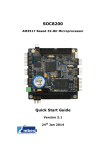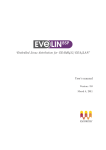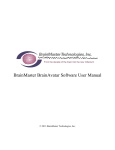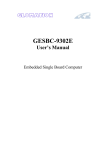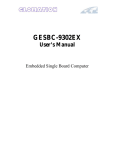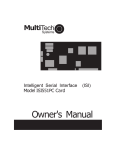Download Embedded Linux Project
Transcript
Embedded Linux Project FIRST DRAFT Kevin Wu June 24, 2008 Contents 1 2 3 4 5 6 7 8 9 10 11 12 About This Document . . . . . . . . . . . . . . . . . . . . . . . 1.1 Audience . . . . . . . . . . . . . . . . . . . . . . . . . . 1.2 Status Log Quotes . . . . . . . . . . . . . . . . . . . . . 1.3 Code and Shell Snippets . . . . . . . . . . . . . . . . . . Background . . . . . . . . . . . . . . . . . . . . . . . . . . . . SBC Project Ideas . . . . . . . . . . . . . . . . . . . . . . . . . Glomation GESBC-2440 . . . . . . . . . . . . . . . . . . . . . . 4.1 Bootloader . . . . . . . . . . . . . . . . . . . . . . . . . 4.2 Pre-installed Kernel . . . . . . . . . . . . . . . . . . . . 4.3 init and BusyBox . . . . . . . . . . . . . . . . . . . . . . Cross-development Toolchain . . . . . . . . . . . . . . . . . . . 5.1 crosstool . . . . . . . . . . . . . . . . . . . . . . . . . . Linux Kernel . . . . . . . . . . . . . . . . . . . . . . . . . . . . S3C2440 ADC Project . . . . . . . . . . . . . . . . . . . . . . . Loading Kernel Onto GESBC-2440 . . . . . . . . . . . . . . . . Mounting Root Filesystem over NFS . . . . . . . . . . . . . . . 9.1 U-Boot bootargs for Mounting Root Filesystem Over NFS 9.2 fstab and inittab . . . . . . . . . . . . . . . . . . . . . . Hello, World Kernel Module . . . . . . . . . . . . . . . . . . . Miscellaneous . . . . . . . . . . . . . . . . . . . . . . . . . . . Conclusions, Future Work . . . . . . . . . . . . . . . . . . . . . i . . . . . . . . . . . . . . . . . . . . . . . . . . . . . . . . . . . . . . . . . . . . . . . . . . . . . . . . . . . . . . . . . . . . . . . . . . . . . . . . . . . . . . . . . . . . . . . . . . . . . . . . . . . . . . . . . . . . . . . . . . . . . . . . . . . . . . . . . . . . . . . . . . . . . . . . . . . . . . . . . . . . . . . . . . . . . . . . . . . . . . . . . . . . . . . . . . . . . . . . . . . . . . . . . . . . . . . . . . . . . . . . . . . . . . . . . . . . . . . . . . . . . . . . . . . . . . . . . . . . . . . . . . . . . . . . . . . . . . . . . . . . . . . . . . . . . . . . . . . . . . . . . . . . . . . . . . . . . . . . . . . . . . . . . . . . . . . . 1 1 1 1 2 3 4 4 5 5 7 7 8 10 11 12 14 14 16 18 19 Embedded Linux Project 1 About This Document About This Document I am writing this document, not as a part of an assignment or of cial project, but for record keeping purposes. As such, you may nd the tone to be somewhat colloquial, and the formatting to be unconventional. 1.1 Audience This document is intended for anybody. Depending on who you are, though, you might nd this content to be trivial. I can only hope that the circumstances that I describe in section 2, Background, give you some perspective into where this is all coming from. 1.2 Status Log Quotes Throughout this document, I will often copy-paste bits and pieces from a status log that I kept while I experimented and made progress. here is an example of what some text from my status log will look like in this document. i don't really bother with syntax or grammar, and it appears like i am just chatting with someone online. These quotes show my thought process as I worked. With things happening so fast, I felt it would behoove me to keep a log that I could reference later if I needed to remember something. For each part that I describe in this document, I will try to include a piece from my log that gives more color to the situation, instead of paraphrasing everything. 1.3 Code and Shell Snippets Code, commands, and standard output all look like this. Kevin Wu 1 Embedded Linux Project 2 Background Background In the spring of 2008, I took a class called Embedded Linux. It was a 10-week course at UCSD Extension, and my rst experience with embedded Linux. We met once a week for about 2 hours. Including myself, there were 10 people enrolled. Our textbook was Building Embedded Linux Systems by Karim Yaghmour. The teacher attempted to cover one chapter per class, using Powerpoint presentations to summarize each chapter. Prior to this class, I'd had casual experience with Linux from trying out various distributions on my desktop computer. I've settled with using Ubuntu for both my desktop and laptop, along with Windows, so I used it as my host system for the class. Ubuntu supposedly makes things easy. I say supposedly because I can't claim that it's something I can fully appreciate, since I grew up using Windows. But from what I have read, and from my tinkerings with Linux, it seems that making Linux easy and accessible is an impossibly enormous undertaking. After taking this class, I am even more impressed. Since embedded Linux was a new subject for me, I spent a lot of time reading the textbook. I started from the very beginning, and by the end of the class I had covered through chapter 6, and had also skimmed chapter 7. In this class, we had the option of either doing weekly quizzes, or to do something interesting of our choosing with a single-board computer (SBC) that could run Linux. I chose the second option because I felt it would be more enlightening than simply reading the textbook and doing written quizzes. For those of us who chose this path, the teacher recommended that we purchase an SBC that already had a Linux distribution installed, and directed us to Gumstix and Glomation. I bought the Glomation GESBC-2440 because it seemed relatively new and had plenty of built-in features, the most important of which was the ethernet interface. Even though I wasn't sure what interesting thing I would do with the board, I wanted the board to allow me enough options. Kevin Wu 2 Embedded Linux Project 3 SBC Project Ideas SBC Project Ideas Since the project was left open-ended, it was up to me to decide what to do with my SBC. It was dif cult to come up with a concrete project idea because I did not fully know what my board could do, much less how to work with an embedded Linux system. Some people wanted to roll their own Linux distribution, which sounded interesting, but maybe too challenging given the time constraints of the class. At the same time, even though I bought an SBC with Linux pre-installed and cross-development toolchain already built, I didn't want everything to be simply handed to me as such. I wanted to know what building an embedded Linux system entailed, to do at least a part of it, and then to develop an application for it. With this vague goal in mind, I began to think about some possible programs I could develop that would eventually run on my SBC. I wanted my SBC to do something practical, to do something that I would actually use. I soon discovered that learning about and working with my SBC and embedded Linux systems would severely limit the scope of any application I hoped to develop. Kevin Wu 3 Embedded Linux Project 4 4.1 Glomation GESBC-2440 Glomation GESBC-2440 Bootloader The GESBC-2440 uses U-Boot as its bootloader. U-Boot 1.1.2 (Nov 15 2006 - 01:41:13) U-Boot code: 33C00000 -> 33C25CC8 BSS: -> 33C5F610 RAM Configuration: Bank #0: 30000000 64 MB Get flash bank 0 size @ 0x0 Total Flash bank's sizes: 0x200000 protect monitor 25cc8 bytes @ address 0 Flash: 2 MB Kevin Wu 4 Embedded Linux Project Glomation GESBC-2440 NAND:Flash chip found: Manufacturer ID: 0xEC, Chip ID: 0x76 (Samsung unknown 64Mb) 1 flash chips found. Total nand_chip size: 64 MB 64 MB In: serial Out: serial Err: serial Found DM9000 ID:90000a46 at address 18000000, ethaddr = 08:00:3e:26:0a:5b! DM9000 work in 16 bus width Not link of ethernet Hit any key to stop autoboot: 1 0 SBC2440A# 4.2 Pre-installed Kernel A patched version of Linux 2.6.18.2 came pre-installed on the GESBC-2440. NAND read: device 0 offset 0, size 1293736 ... 1293736 bytes read: OK ## Booting image at 33000000 ... Image Name: Linux-2.6.18.2 Created: 2007-10-28 3:50:20 UTC Image Type: ARM Linux Kernel Image (uncompressed) Data Size: 1293672 Bytes = 1.2 MB Load Address: 30008000 Entry Point: 30008000 Verifying Checksum ... OK OK Starting kernel ... Uncompressing Linux............................................................ ........................ done, booting the kernel. Linux version 2.6.18.2 (root@GESBC) (gcc version 4.1.2 20061115 (prerelease) (Debian 4.1.1-21)) #586 Sun Oct 28 03:48:37 UTC 2007 CPU: ARM920T [41129200] revision 0 (ARMv4T), cr=c0007177 Machine: SBZ2440 Memory policy: ECC disabled, Data cache writeback CPU S3C2440A (id 0x32440001) S3C244X: core 399.651 MHz, memory 133.217 MHz, peripheral 66.608 MHz S3C24XX Clocks, (c) 2004 Simtec Electronics CLOCK: Slow mode (2.116 MHz), fast, MPLL on, UPLL on ... 4.3 init and BusyBox The GESBC-2440 uses BusyBox as its login and shell. After the kernel is loaded and the root lesystem is mounted, the system enters runlevel 5 and runs one script, /etc/rcS, which mounts lesystems, starts Opie, and starts BusyBox. VFS: Mounted root (jffs2 filesystem). Freeing init memory: 112K Vendor: Chipsbnk Model: Flash Disk Rev: 5.00 Type: Direct-Access ANSI SCSI revision: 02 SCSI device sda: 2061824 512-byte hdwr sectors (1056 MB) sda: Write Protect is off sda: assuming drive cache: write through s3c2410-sdi s3c2410-sdi: powered down. Kevin Wu 5 Embedded Linux Project Glomation GESBC-2440 SCSI device sda: 2061824 512-byte hdwr sectors (1056 MB) sda: Write Protect is off sda: assuming drive cache: write through sda: sda1 sd 0:0:0:0: Attached scsi removable disk sda mount /etc as ramfs mount /dev as tmpfs mounting all Scanning hardware You seem to already have a /home/root/Applications directory. Assuming it is the Opie Applications directory. Exiting. Starting Opie.... ODevice() - found `Hardware: SBZ2440' ODevice() - unknown hardware - using default. OGlobal::creating global configuration instance. OConfig::OConfig() <unknown>: ODevice reports transformation to be 0 <unknown>: setting QWS_DISPLAY to `Transformed:Rot0:0' qt_init() - starting in daemon mode... Please press Enter to activate this console. BusyBox v1.4.1 (2007-03-25 03:24:25 CST) Built-in shell (ash) Enter `help' for a list of built-in commands. [root@(none) /]# uname -m uname -m armv4tl While BusyBox is full-featured, it was dif cult to use vi, or to do tab-completion, or to edit shell commands in place, because all control and navigation characters appeared on the screen when they are typed. Perhaps these issues have been xed in later versions. I thought it might have been my terminal emulator, so I tried various emulators and settings, and found PuTTY to work the best, but control characters still appeared. ... [root@(none) /]# ^[[A^[[B^[^[^[ ... "rcS" 17L, 343C0^[^[^[^[^[^[lllllllllllllllllllllllllllllllllllllllllllllllllll llllllllllllllllla I rcS [modified] 19/19 100%udhcpc -i eth0 -b -p /var/run/udhcpc.eth0 >/dev/null 2>&1^[:wq ~- rcS 1/19 5%^[jjjjjjjjjjjjjjjjjjjjjjj ^[kk - rcS 19/19 100%- rcS 18/19 94%- rcS 17/19 89%- rcS 18/19 94%^[kk - rcS 18/19 94%- rcS 17/19 89%- rcS 16/19 84%- rcS 17/19 89%x^[:wq ... Kevin Wu 6 Embedded Linux Project 5 Cross-development Toolchain Cross-development Toolchain I learned the hard way that building a cross-development toolchain depends highly on the version of gcc that is used to do the build. gnuarm.com groups packages for binutils, gcc, and newlib according to the version of gcc installed on your host; but before I realized this, I tried building my own versions and ran into countless compilation errors. Unfortunately, even with the nicely grouped packages from gnuarm.com, I could not get past building the bootstrap gcc. From my project log: ok, binutils build a success. gcc-4.2 is ok so far. now for building bootstrap gcc. congure went without a hitch. huh. i even used without-headers. not sure if that is because it's been xed, or whether i'm just building the correct version for the version of gcc i have installed. uh oh.. ../../gcc-4.1.1/gcc/gthr-posix.h:43:21: error: pthread.h: No such file or directory ../../gcc-4.1.1/gcc/gthr-posix.h:44:20: error: unistd.h: No such file or directory so far everyone seems to be saying that i need a c library before i try to compile the bootstrap compiler. so why doesn't the book say that? ARGH. trying gcc-4.1 to build bootstrap gcc. same problem tired. moving onto trying to build glomation kernel using glomation toolchain. i think i still need to compile the toolchain though. argh. It seemed like picking the correct versions of the different components would take a lot of guess-and-check work, which I didn't have time to do. 5.1 crosstool I almost gave up and used the toolchain provided by Glomation, but decided to try something that I found while googling compilation errors, called crosstool. It is a script that basically does all the work of trying different version combinations. In fact, there is a matrix, created from the author's own buildlogs created by the script, that shows which combinations work and don't work. i looked for one that had the glibc installed on the board (2.3.2), and a gcc_core_dir that matched one i could just apt-get from the ubuntu repos (3.3.6). i edited the corresponding combination's .dat le and explicity included the gcc_core_dir variable, explained here: crosstool-vars.html and i ln -s -f /usr/bin/gcc-3.3 /usr/bin/gcc, just in case. so, here goes, before i end up using glomation's toolchain. ok, turns out some automatically generated les weren't being generated properly.. crbuild-glibc/csu/version-info.h missing terminating '' character. did some googling (googled for crosstool build-glibc/csu/version-info.h missing terminating character) and it's because of the freakin shell. i thought i was using bash.. but it turns out, ubuntu uses dash. so, i did the symbolic link to bash.. and even used bash to execute the script.. and it worked!!!!!!!!!! crosstool: final gcc built ok Cross-toolchain build complete. Result in /opt/crosstool/gcc-3.3.6-glibc-2.3.2/arm-unknown-linux-gnu. testhello: C compiler can in fact build a trivial program. Done. I successfully compiled the obligatory hello world program and ran it on my board, as well as the utility: le [root@(none) gesbc-2440_binaries]# ./file -m magic helloworld ./file -m magic helloworld helloworld: ELF 32-bit LSB executable, ARM, version 1, for GNU/Linux 2.4.18, dynamically linked (uses shared libs), not stripped I later had to recreate a toolchain using crosstool because compiling my kernel required gcc v3.4.3 or higher. Kevin Wu 7 Embedded Linux Project 6 Linux Kernel Linux Kernel For the GESBC-2440, Glomation provides kernel version 2.6.18.2. Still, I wanted my own kernel: i tried getting the latest stable kernel from kernel.org, then getting the latest patch from arm.linux.org.uk. i patched the kernel source ne.. but when i did make menucong, i got an error from mconf.c. did some search, and it turns out it's because my gcc (the ones from the esty repos.. for my c/c++ class) is too new.. v4.1 or whatever. i need to use gcc v3.4 or something instead. i found a way to get around it, though.. use this patch: Index: package/config/mconf.c ============================================== --- package/config/mconf.c (revision 10888) +++ package/config/mconf.c (working copy) @@ -101,7 +101,7 @@ static int indent = 0; static struct termios ios_org; static int rows, cols; -static struct menu *current_menu; +struct menu *current_menu; static int child_count; static int single_menu_mode; so, that worked.. but then i got a whole dierent slew of errors, similar to the ones i got when i tried to make menucong with the glomation kernel source. i picked a line and did a google search.. found this: stack_chk_fail. basically i needed to install ncurses-dev. craziness. so anyway, now i'm in the menucong. i'm unsure about almost everything. currently stuck on con- g_embedded.. I con gured the kernel based on the help blurbs for each option, but I soon noticed that my kernel didn't have options related to the S3C2440 or S3C2410. I was confused as to how each architecture gets added to the kernel. tried to nish conguring the kernel, even though i think it won't work because i don't have the cong options for the s3c2440. tried doing some google searches for s3c2440 linux kernel version, stu like that. at this point i'm pretty tired.. not sure how it all comes together. how does the specic information for certain chips get added to kernel code? if that specic info isn't there, does linux not work on that chip? or does it just run a very generic version of linux that is specic to the generic architecture? i mean, aren't there dierent versions of x86? i guess dierent x86 chips have dierent features.. but is the kernel code mature enough such that all those dierent chips are included? i don't feel like compiling the toolchain now. maybe i will just use the glomation ones. i'm starting to understand why don recommends linux already on the board. it would denitely be easier. that would mean i just need to congure anjuta to use the glomation toolchain, instead of the toolchain already on my ubuntu, and i would just need to read the s3c2440 spec sheet to do some programming to manipulate the pins. but then i'm not really learning as much. and i've already sort of gotten myself this deep into it. i just don't understand how to get the right kernel, how to nd out whether the s3c2440 is more or less supported in specic versions of the kernel. that is the big mystery now. is it more supported in debian? i looked at the debian etch glomation package and it's just the lesystem layout, no kernel source code or whatever. I eventually gured out that I didn't need to be concerned about it. i went back to the main page of arm.linux.co.uk, went to developers, then i clicked on kernel compilation, kerncomp.php. very useful info, ESPECIALLY THIS: (note: kernels later than 2.6.0-test2 do not require a -rmk or -vrs patch to be applied since ARM architecture support is already merged.) AMAZING! i think that's where my confusion was. i thought from the start that i needed an arm kernel patch, so i looked for the latest one at kernel-patches/v2.6/. the latest one was for a 2.6.0 kernel, so i downloaded that kernel. it turns out arm support was merged into kernels after that, so i can just download the latest one and it should have arm, as well as my s3c2440.. which, i have just conrmed, it does! sweeeeeettt. . . Kevin Wu 8 Embedded Linux Project Linux Kernel Ultimately, I used the kernel package provided by Glomation. I learned that even though I had architecture support, my peripherals wouldn't necessarily work, and that device drivers would need to be written for them. I thought maybe I could do a diff between the Glomation-provided kernel and the kernel of the same version from kernel.org, and determine what device driver patches were created: i've been looking at the les that are dierent, and i have no idea what is going on.. it's all c, but, i don't understand it. eh. i wonder whether i can merge the dierences into the latest kernel. but i think i want to understand why there are dierences and how whoever made the changes knew what changes to make. ... how can i upgrade from glomation to the latest? would it be possible to patch the glomation kernel? that might not work, because patching depends on certain lines being in there. if stu was changed around, then the patch might not get implemented. the long hard way would be to gure out WHY things were patched. go through each changed le, and gure out why it was changed. then try to implement the same changes, manually, in the latest kernel. Kevin Wu 9 Embedded Linux Project 7 S3C2440 ADC Project S3C2440 ADC Project After getting a better grasp of my board, the toolchain, and the kernel, I decided that my project would be to use the ADC to report voltage from a solar cell (photovoltaic cell). Even though I felt that it would be a fairly simple project (we had programmed the ADC on our Atmel AtTiny44 boards in my ECP3 class), I didn't know where to begin, or what this endeavor would entail. I began by purchasing some PV cells from Edmund Scienti c, and reading up on the ADC in the S3C2440 datasheet. I wanted to program the ADC in the same way I programmed it for the AtTiny44, by simply writing values to a register name and checking the results stored in another register. I looked up the register names in the kernel header les and found that ADCCON is the con guration register, while the rst 10 bits of ADCDAT0 would hold conversion results. I wrote a program to simply read from the ADCCON register, but got segmentation fault. I learned that segmentation fault meant I was trying to access a memory address that I wasn't allowed to access. I contacted Glomation about whether they had any sample code for talking to the ADC. This is where things became complicated. Dear Kevin Wu, We currently do not have any sample code to access the ADC on the S3C2440 chip. There are 2 ways to access the on-chip ADC of the S3C2440, a Linux device driver or a simple user space program. The device driver approach requires some in-depth knowledge of the Linux device drivers and is a little more complicated than the user space program but it provides system level access to the on-chip ADC. The user space program is simple to program and provide simple access of the on-chip ADC. Here is a link to a user space program that can access any memory location of the Linux system, devmem2.c. Since the on-chip ADC is memory mapped, you can actually access the ADC just using the devmem2 program in a sequence of writes and reads of the ADC registers. Please refer to the S3C2440 data sheet on how to program the ADC. Please be noted that the default installed kernel include a touch screen driver for the GESBC-2440 SBC which uses the on-chip ADC as touch screen interface. You will need to disable the touch screen driver from the kernel in order to use the on-chip ADC. Regards, Glomation Customer Support I compiled and ran devmem2 on my target. I read the value at the ADCCON address (0x5800000) to check whether it matched the reset value given in the datasheet, but it didn't. So I recompiled the kernel without touchscreen support, and created a uImage, which is the kernel image format that U-Boot accepts. Kevin Wu 10 Embedded Linux Project 8 Loading Kernel Onto GESBC-2440 Loading Kernel Onto GESBC-2440 Loading the kernel is all done in U-Boot, my target's bootloader. In order to load the kernel image onto the NAND ash on my target, I had to erase the NAND by issuing the command: nand erase clean Then I load the uImage onto the SDRAM chip via a TFTP server running on my host (I used this one), with the uImage le located in the TFTP server's shared folder: set ipaddr 192.168.xxx.xxx set serverip 192.168.xxx.xxx tftp 33000000 uImage This sets the target and server (host) IP addresses, and begins the TFTP transfer of uImage. Once the image is in SDRAM, I transfer it to the NAND ash: nand write.jffs2 33000000 0 $(filesize) write.jffs2 is used because the NAND is formatted with JFFS2 lesystem. It reads/writes ` lesize' bytes, starting at offset 0, to/from memory address 33000000. The lesize variable holds the size, in hex, of the image read from the last tftp command. Now I have to tell U-Boot where the kernel image is: set bootcmd `nand read.jffs2 33000000 0 $(filesize); bootm 33000000' This simply tells U-Boot that the bootable image is located at address 33000000, offset 0, and image size ` lesize'. Loading the kernel was successful. My target booted, and I saw that it was indeed the kernel I had compiled. NAND read: device 0 offset 0, size 1307664 ... 1307664 bytes read: OK ## Booting image at 33000000 ... Image Name: Linux-2.6.18.2 Created: 2008-06-18 3:11:52 UTC Image Type: ARM Linux Kernel Image (uncompressed) Data Size: 1307600 Bytes = 1.2 MB Load Address: 30008000 Entry Point: 30008000 Verifying Checksum ... OK OK Starting kernel ... Uncompressing Linux............................................................ ......................... done, booting the kernel. Linux version 2.6.18.2 (wuziq@wuziq-laptop-linux) (gcc version 3.4.5) #2 Tue Jun 17 20:11:48 PDT 2008 CPU: ARM920T [41129200] revision 0 (ARMv4T), cr=c0007177 Machine: SBZ2440 Memory policy: ECC disabled, Data cache writeback CPU S3C2440A (id 0x32440001) S3C244X: core 399.651 MHz, memory 133.217 MHz, peripheral 66.608 MHz S3C24XX Clocks, (c) 2004 Simtec Electronics CLOCK: Slow mode (2.116 MHz), fast, MPLL on, UPLL on ... Unfortunately, I didn't realize that my root lesystem was also located on the NAND ash, so I had accidentally erased it when I issued the nand erase clean command. Kevin Wu 11 Embedded Linux Project 9 Mounting Root Filesystem over NFS Mounting Root Filesystem over NFS With time running out, I needed a new root lesystem as soon as possible. Although I read the chapter on how to set up the root lesystem, I hadn't actually done the work. I looked at the Glomation support site and saw that they provided a Debian-based le system for use on a USB drive. I tried downloading it, but discovered it was over 200 MB, so it wouldn't t on my target by any means. I attempted to unpack it onto my USB stick, but there were permissions issues, which I think were resulting from the fact that my USB stick was formatted as fat16 instead of ext2. Then I noticed instructions for mounting the root le system over NFS. They were for a Glomation board different from mine, but I used what I could and gured out the rest. i'm noticing on USB-as-root-le-system.txt that it's just a matter of specifying where the rootfs in the bootloader. i think i could just follow the user manual instructions for set up uboot boot environment and change the bootargs to `root=dev/sda1/rootfsfolder rw rootfstype=vfat noinitrd init=/linuxrc console=ttySAC0,115200'. i think i'll try it. the rootfs package just nished downloading. and luckily my thumbstick is 1gb. ok, there are some permissions issues in the rootfs package. i could sudo untar it to my host, but not to the thumbstick. hmmmm. . . ok what about nfs? looking at Ubuntu:Gutsy#NFS_Server and nfs-rootfs-setup-linux.txt. seeeeeems doable. but then so did usb. sudo apt-get install nfs-kernel-server nfs-common portmap sudo dpkg-reconfigure portmap sudo /etc/init.d/portmap restart sudo /etc/init.d/nfs-kernel-server restart sudo exportfs -a wuziq@wuziq-laptop-linux:~/gesbc-2440/rootfs_nfs$ rpcinfo -p program vers proto port 100000 2 tcp 111 portmapper 100024 1 udp 36513 status 100024 1 tcp 38860 status 100000 2 udp 111 portmapper 100003 2 udp 2049 nfs 100003 3 udp 2049 nfs 100003 4 udp 2049 nfs 100021 1 udp 37927 nlockmgr 100021 3 udp 37927 nlockmgr 100021 4 udp 37927 nlockmgr 100003 2 tcp 2049 nfs 100003 3 tcp 2049 nfs 100003 4 tcp 2049 nfs 100021 1 tcp 60456 nlockmgr 100021 3 tcp 60456 nlockmgr 100021 4 tcp 60456 nlockmgr 100005 1 udp 32974 mountd 100005 1 tcp 46968 mountd 100005 2 udp 32974 mountd 100005 2 tcp 46968 mountd 100005 3 udp 32974 mountd 100005 3 tcp 46968 mountd seems to look ok. ok, now to try booting. dude i think it worked! s3c2410-sdi s3c2410-sdi: powered down. Sending DHCP requests ., OK IP-Config: Got DHCP answer from 192.168.2.1, my address is 192.168.2.109 Kevin Wu 12 Embedded Linux Project Mounting Root Filesystem over NFS IP-Config: Complete: device=eth0, addr=192.168.2.109, mask=255.255.255.0, gw=192.168.2.1, host=192.168.2.109, domain=, nis-domain=(none), bootserver=192.168.2.1, rootserver=192.168.2.101, rootpath= Looking up port of RPC 100003/2 on 192.168.2.101 Looking up port of RPC 100005/1 on 192.168.2.101 VFS: Mounted root (nfs filesystem). Freeing init memory: 112K SBZ: try run /sbin/init INIT: version 2.86 booting devfsd: No devfs on /dev, not starting. The device node /dev/sda1 for the root filesystem is missing, incorrect, or there is no entry for the root filesystem listed in /etc/fstab. The system is also unable to create a temporary node in /dev/shm to use as a work-around. This means you have to fix this manually. CONTROL-D will exit from this shell and REBOOT the system. Press enter for maintenance (or type Control-D to continue): ok.. i don't know what those errors are about.. but i'm poking around and i think it worked!!!!!!! root@192:/# cd .. root@192:/# ls bin/ dev/ home/ lib/ mnt/ opt/ root/ sys/ usr/ boot/ etc/ initrd/ lost+found/ nfsroot/ proc/ sbin/ tmp/ var/ root@192:/# uname Linux root@192:/# ifconfig eth0 Link encap:Ethernet HWaddr 80:E2:66:60:00:01 inet addr:192.168.2.109 Bcast:192.168.2.255 Mask:255.255.255.0 UP BROADCAST RUNNING MULTICAST MTU:1500 Metric:1 RX packets:2878 errors:0 dropped:0 overruns:0 frame:0 TX packets:1538 errors:0 dropped:0 overruns:0 carrier:0 collisions:0 txqueuelen:1000 RX bytes:0 (0.0 b) TX bytes:0 (0.0 b) Interrupt:51 Base address:0xe000 lo Link encap:Local Loopback inet addr:127.0.0.1 Mask:255.0.0.0 UP LOOPBACK RUNNING MTU:16436 Metric:1 RX packets:0 errors:0 dropped:0 overruns:0 frame:0 TX packets:0 errors:0 dropped:0 overruns:0 carrier:0 collisions:0 txqueuelen:0 RX bytes:0 (0.0 b) TX bytes:0 (0.0 b) The rst thing I noticed is that I no longer had the vi, control character, or tab-completion problems that I had with BusyBox (see subsection 4.3). I was essentially using a standard Linux shell. Also, this root lesystem already came loaded with many more applications, including apt-get. root@192:etc# apt-get update Get:1 http://http.us.debian.org stable/main Packages [5449kB] Kevin Wu 13 Embedded Linux Project Get:2 http://http.us.debian.org Get:3 http://http.us.debian.org Get:4 http://http.us.debian.org Get:5 http://http.us.debian.org Get:6 http://http.us.debian.org Fetched 5574kB in 49s (114kB/s) Reading Package Lists... Done 9.1 Mounting Root Filesystem over NFS stable/main Release [94B] stable/contrib Packages [53.6kB] stable/contrib Release [97B] stable/non-free Packages [71.0kB] stable/non-free Release [98B] U-Boot bootargs for Mounting Root Filesystem Over NFS Here is how I set the boot arguments in U-Boot: set bootargs `nfsroot=192.168.xxx.xxx:/home/wuziq/gesbc-2440/rootfs_usb rw console=ttySAC0,115200 ip=dhcp nfsroot tells U-Boot to look at address 192.168.xxx.xxx and directory /home/wuziq/gesbc-2440/rootfs_usb for the root lesystem. console con gures the console, and ip=dhcp tells U-Boot to use DHCP to obtain an IP address. Saving these U-Boot environment variables is done with: saveenv 9.2 fstab and inittab The fstab le that came with the root lesystem included a line to mount /dev/sda1 as the root lesystem. Since the root lesystem is already mounted over NFS, I simply removed that line. This xed the no entry for the root lesystem listed in /etc/fstab error, and allowed inittab to execute during bootup. inittab, however, was not con gured properly, so after executing the scripts in /etc/rc2.d, I got: INIT: no more processes in this runlevel I gured out that it was because the terminal con guration at the end of the le was for a different board with different terminal settings: T0:23:respawn:/sbin/getty -L ttyAM0 57600 vt100 T1:23:respawn:/sbin/getty -L ttyAM1 57600 vt100 I replaced those two lines with my terminal settings: T0:23:respawn:/sbin/getty 115200 console and it works. w0000000ttt. VFS: Mounted root (nfs filesystem). Freeing init memory: 112K INIT: version 2.86 booting devfsd: No devfs on /dev, not starting. Cannot access the Hardware Clock via any known method. Use the --debug option to see the details of our search for an access method. Cannot access the Hardware Clock via any known method. Use the --debug option to see the details of our search for an access method. Cleaning up ifupdown...done. Checking all file systems... fsck 1.37 (21-Mar-2005) ... done. Setting up networking...done. Starting hotplug subsystem: usb isapnp ide scsi. Setting MAC address to 00:11:22:33:44:55 Kevin Wu 14 Embedded Linux Project Mounting Root Filesystem over NFS SIOCSIFHWADDR: Device or resource busy Setting up IP spoofing protection: rp_filter. Enabling packet forwarding...done. Configuring network interfaces...done. Starting portmap daemon: portmap. Cannot access the Hardware Clock via any known method. Use the --debug option to see the details of our search for an access method. Running ntpdate to synchronize clock. Recovering nvi editor sessions... done. INIT: Entering runlevel: 2 Starting internet superserver: inetd. Starting OpenBSD Secure Shell server: sshd. Starting NFS common utilities: statd. Starting NFS servers: nfsd mountd. Starting periodic command scheduler: cron. Starting web server: apache-ssl. Debian GNU/Linux 3.1 GESBC-93xx console GESBC-93xx login: root Last login: Fri Sep 1 08:00:52 2006 on ttyAM0 Linux GESBC-93xx #31 Thu Mar 23 13:01:48 MST 2006 armv4l GNU/Linux The programs included with the Debian GNU/Linux system are free software; the exact distribution terms for each program are described in the individual files in /usr/share/doc/*/copyright. Debian GNU/Linux comes with ABSOLUTELY NO WARRANTY, to the extent permitted by applicable law. root@GESBC-93xx:root# ls adc_test* adc_test_new* devmem2_test* word.log adc_test.c adc_test_new.c halfword.log word_part2.log adc_test.o adc_test_new.o memory_log.txt Kevin Wu 15 Embedded Linux Project 10 Hello, World Kernel Module Hello, World Kernel Module Gauging from the progress of my classmates from their weekly updates, I felt that mounting a root lesystem over NFS was presentable material for my nal project. Nevertheless, I had one more day until the last class, where we would be presenting our projects, and I still wanted to do what I had originally intended with the ADC. I tried devmem2 again, but I was getting the same results as before. Were the kernel recon guration and recompilation for nothing? I tried writing a value to the ADCCON register address, then reading the value back, but the value remained the same as before the write: root@192:root# devmem2 0x5800000 h 0x5901 /dev/mem opened. Memory mapped at address 0x40017000. Value at address 0x5800000 (0x40017000): 0x12 Written 0x5901; readback 0x12 I felt that I had done all I could do. But then I talked to a couple coworkers about accessing memory locations. They reminded me that the OS would prevent me from directly accessing memory, and that a device driver would probably be needed. (10:58:34 AM) coworker: so (10:58:39 AM) coworker: write a little c program (10:59:12 AM) coworker: that sets uint16* ptr = 0x5800000 and writes to it (10:59:25 AM) coworker: and then trys 0x40017000 to write to it (10:59:28 AM) coworker: see if either works (10:59:59 AM) coworker: if that doesn't work, modify an existing drive to do it (10:59:59 AM) me: i tried the rst line, i get segmentation fault (11:00:20 AM) coworker: what about second line (11:00:26 AM) me: devmem2 does the second line (11:00:47 AM) coworker: u dont need to write a whole driver (11:00:58 AM) coworker: just insert some code into an existing driver (11:01:01 AM) coworker: to do it (11:01:07 AM) coworker: to see if it works (11:01:07 AM) me: HMMMMMMMMMMMMMMM (11:01:14 AM) me: very interesting (11:01:23 AM) coworker: thats what i would do cuz it's easy (11:01:26 AM) me: a driver that the kernel is already using (11:01:30 AM) coworker: ya (11:01:36 AM) me: very interesting This new information set me on a path that never crossed my mind for this class: writing a Linux device driver. There was a book at my workplace, called Linux Device Drivers, 2nd Edition ( LDD2 ). I ipped through the pages, not understanding anything, except for the Hello, World program at the beginning. I gured I would at least try writing and loading it, and then go on from there. This decision led me to a few hours of trying to debug compilation errors. I couldn't even get the module to compile on my host. I nally realized that LDD2 was aimed at kernel version 2.4, and, from what I had read while debugging compilation errors, kernel version 2.6 handles modules in a very different way. I checked for a newer version of LDD, and found Linux Device Drivers, 3rd Edition at lwn.net. I also downloaded the driver examples from the author's FTP site. I tried executing make, but it was looking for kernel headers whose version matched my kernel version (2.6.18.2). I had installed the kernel source tree on my target, but my target also had slightly newer kernel headers loaded onto it as well, along with -s3c2410 appended to the source tree name. After some sloppy renaming, the make worked, but upon insmod-ing, I got: Kevin Wu 16 Embedded Linux Project Hello, World Kernel Module root@GESBC-93xx:misc-modules# insmod ./hello.ko hello: version magic `2.6.18-6-s3c2410 mod_unload ARMv4 gcc-4.1' should be `2.6.18.2 mod_unload ARMv4 gcc-3.4' insmod: error inserting `./hello.ko': -1 Invalid module format It turns out that make is using some information it nds in the kernel source tree to gure out version stuff. This is actually explained in LDD3. I found out that you can point make to your kernel source tree by setting the KERNELDIR variable. After setting KERNELDIR, and creating arm-linux-gcc and arm-linux-ld symbolic links to my crosstool-created toolchain binaries, the make ran successfully, and modinfo showed matching magic versions: wuziq@wuziq-laptop-linux:~/...$ modinfo hello.ko filename: hello.ko license: Dual BSD/GPL depends: vermagic: 2.6.18.2 mod_unload ARMv4 gcc-3.4 Finally, I successfully loaded and unloaded the driver: root@GESBC-93xx:misc-modules# Module Size root@GESBC-93xx:misc-modules# Hello, world root@GESBC-93xx:misc-modules# Module Size hello 1120 root@GESBC-93xx:misc-modules# Goodbye, cruel world root@GESBC-93xx:misc-modules# Module Size root@GESBC-93xx:misc-modules# Kevin Wu lsmod Used by insmod ./hello.ko lsmod Used by 0 rmmod hello lsmod Used by 17 Embedded Linux Project 11 Miscellaneous Miscellaneous Here are some little tips that helped me along the way. ˆ To show the U-Boot environment variables, use printenv : SBC2440A# printenv bootdelay=1 baudrate=115200 ethaddr=08:00:3e:26:0a:5b filesize=1f44000 fileaddr=30000000 gatewayip=192.168.0.1 netmask=255.255.255.0 serverip=192.168.0.102 ipaddr=ip=192.168.0.8:192.168.0.102:192.168.0.102:255.255.255.0:GESBC:eth0:off bootcmd=nand read.jffs2 33000000 0 13f410; bootm 33000000 bootargs=nfsroot=192.168.0.102:/home/wuziq/gesbc-2440/rootfs_usb rw console=ttySAC0,115200 ip=dhcp stdin=serial stdout=serial stderr=serial Environment size: 458/65532 bytes ˆ To con gure ethernet manually, if there's no DHCP client: ifconfig eth0 192.168.2.103 route add default gw 192.168.2.1 eth0 ifconfig lo 127.0.0.1 echo "nameserver 192.168.2.1" > /etc/resolv.conf ˆ To see all possible options and variables that are con gurable for a con gure script, simply use: ./configure --help ˆ To quickly transfer les from host to target in an ethernet-connected setup, use scp: wuziq@wuziq-laptop-linux:~/...$ scp hello.ko [email protected]:/root/.../ hello.ko 100% 1965 1.9KB/s 00:00 I was able to do this with my NFS-mounted root lesystem. Tab-completion also worked for completing paths on the target, which I thought was pretty cool. Kevin Wu 18 Embedded Linux Project 12 Conclusions, Future Work Conclusions, Future Work Coming soon. . . Kevin Wu 19





















